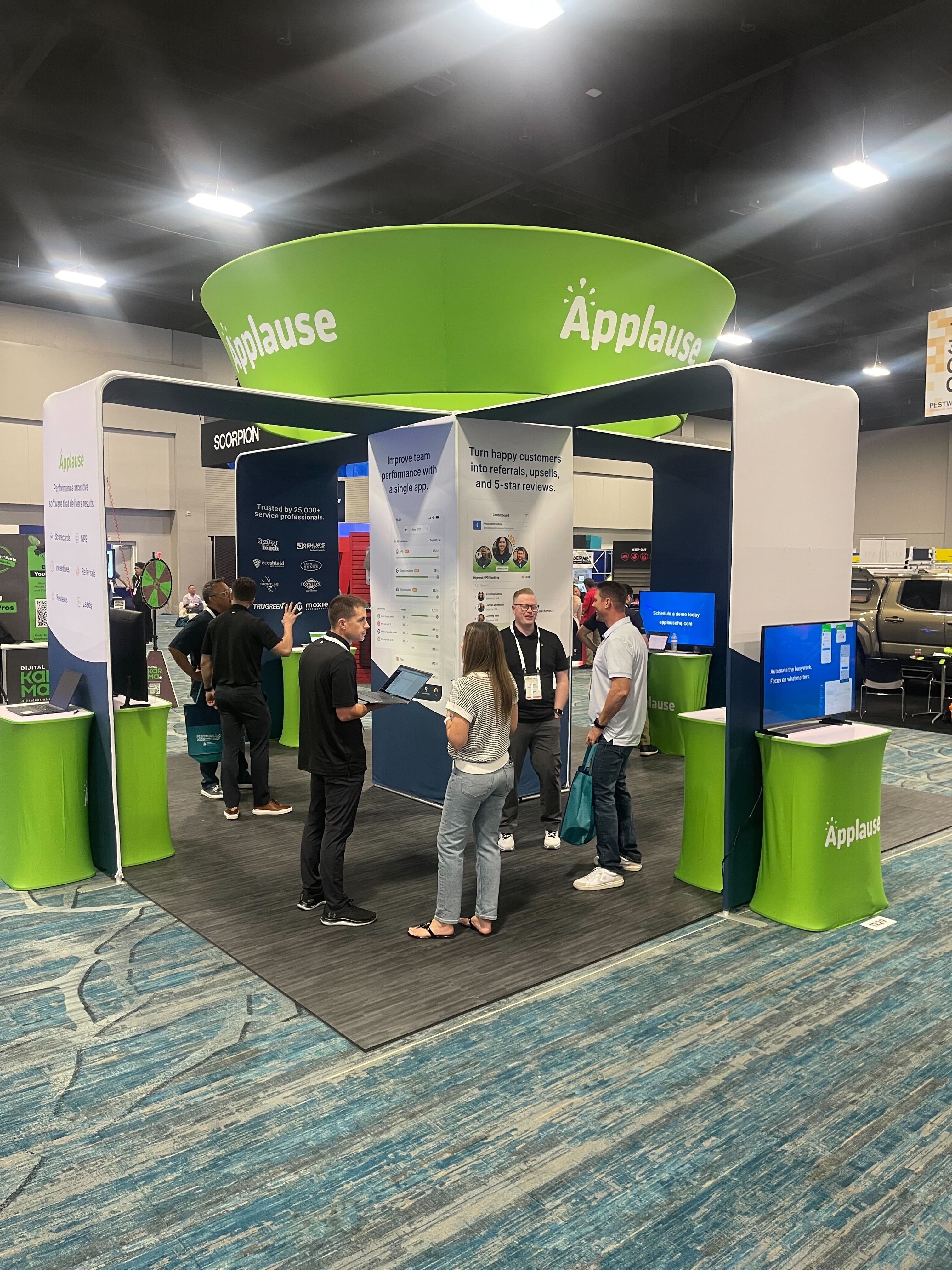In home services, technician performance drives profit. But before you can improve your teams’ performance, you need a consistent, automated way to measure it.
Scorecards unifies technician-level data into a single dashboard your guys can access right from their phones. And it gives you a birds-eye view of how each person on your team is performing so you can quickly spot who’s excelling and who needs coaching.
The result is real-time visibility, fair recognition, and a culture of accountability that motivates everyone on your team to do their best work.
With Scorecards, you can choose which metrics to ingest into your dashboard, as well as the metrics your technicians can view. Some owners track more than 20, while others only care about five or six.
Below, we run through all the data points you can opt to view depending on the CRM you use.
Here are the 50 technician performance metrics you can track right now with Scorecards.
Productivity & output metrics
These metrics show who’s working efficiently, completing their routes, and keeping your operation moving.
- Attendance: Counts the number of days a technician completed at least one job. Great for identifying reliability and consistency in field operations.
- Completed Jobs: Total number of services finished in a given period. A simple way to measure overall output.
- Average Jobs per Day: Completed jobs divided by attendance days. Highlights efficiency and workload capacity.
- Production Value (Total): The total dollar value generated from all completed services. Connects technician performance directly to revenue.
- Average Production per Day: Average daily revenue per technician. Helps you spot who’s consistently contributing to topline growth.
- Average Production per Hour: Total production value divided by total time-on-site. Reveals how effectively time in the field translates into income.
- Average Production per Job: Total production value divided by completed jobs. A strong indicator of ticket size and upsell performance.
- Route Completion: The percentage of scheduled jobs actually completed that day. Reflects dependability and scheduling efficiency.
- Time on Site: Average time spent per job. Ensures visits are thorough but not wasteful — a balance of quality and speed.
- Driving Days: Total days with logged driving data. Confirms active workdays for teams using fleet tracking integrations.
Earnings, tips & bonuses
These metrics connect recognition and reward, motivating technicians through visible progress.
- Bonus Count: The total number of bonuses earned in the current period. Encourages competition and consistency.
- Bonus Amount: Total dollar value of all bonuses. Ties performance directly to financial reward.
- Tip Count: Number of tips received from customers. Reflects quality of interaction and satisfaction on-site.
- Tip Dollars: Total value of tips earned. A direct signal of customer appreciation and trust.
Customer experience & review metrics
In home services, trust is everything. These metrics turn customer sentiment into measurable KPIs.
- Net Promoter Score (NPS): Measures customer loyalty by asking how likely they are to recommend your service (0–10 scale). A benchmark for satisfaction.
- NPS Count: Total number of customer responses received. The higher the count, the more reliable your NPS average.
- NPS Response Rate: Percentage of sent NPS requests that receive responses. Indicates engagement and the strength of customer relationships.
- Google Review Count: Number of Google reviews received for the month. Reflects visibility and online presence.
- Google Review Rating: Average star rating across all Google reviews. Captures the quality of the customer experience.
- 4+ Star Google Reviews: Total of all 4- and 5-star Google reviews. A focused measure of positive sentiment.
- 5-Star Google Reviews: Count of perfect reviews, showing standout customer service moments.
- Facebook Reviews: Total number of Facebook reviews (positive or negative). Measures social feedback volume.
- Positive Facebook Reviews: Number of Facebook recommendations or “yes” responses. Indicates reputation health on social platforms.
- Facebook Rating: Average percentage of positive Facebook reviews. A quick view of brand approval.
Quality & service metrics
These metrics highlight operational precision and quality of work, which is essential for customer retention and cost control.
- Reservice Count: Number of jobs that required a follow-up or redo. A key indicator of quality control and training needs.
- Reservice Rate: Percentage of total jobs that needed a reservice. The lower the better. It signals fewer callbacks and higher first-time fix rates.
- Jobs with Photo: Percentage of jobs that include at least one photo. Ensures documentation standards are followed.
- Average Photos per Job: Average number of photos uploaded per completed job. Shows thoroughness and compliance with company process.
Driving & Safety Metrics (By fleet integration)
For companies that use vehicles daily, driver behavior has a direct impact on costs, liability, and brand perception. Scorecards syncs with top fleet platforms (Azuga, Samsara, Geotab, Linxup, and Verizon Connect) to turn safety data into performance insights.
Azuga metrics
- Driving Score: A composite measure of safe driving habits, based on acceleration, braking, speeding, and idling data.
- Acceleration Score: Measures how often and how severely a technician accelerates. Helps identify aggressive driving patterns.
- Braking Score: Tracks the smoothness of braking. Frequent hard stops can signal unsafe driving or poor route planning.
- Cornering Score: Monitors turns and cornering stability. High scores reflect smooth, controlled handling.
- Speeding Score: Evaluates how often drivers exceed posted speed limits. Keeps safety and fuel efficiency in check.
- Idling Score: Measures time spent idling relative to total driving time. Reducing idling cuts fuel costs.
- Seatbelt Score: Tracks seatbelt use based on onboard data. Promotes safety compliance.
- Distracted Driving Score: Monitors phone use, seatbelt use, and other distraction indicators. Key for reducing risk and insurance costs.
Samsara Metrics
- Harsh Acceleration: Counts rapid accelerations (16+ mph in two seconds). A reliable signal of unsafe or wasteful driving.
- Harsh Braking: Tracks sudden stops or decelerations that may indicate tailgating or inattention.
- Harsh Turning: Flags sharp, unsafe turns that could lead to vehicle wear or accidents.
Geotab metrics
- Acceleration: Detects harsh accelerations exceeding preset g-force thresholds.
- Braking: Identifies forceful deceleration events beyond safety parameters.
- Cornering: Measures lateral g-forces during turns. Consistent smoothness signals safer driving.
- Speeding: Tracks speed limit violations, customizable by tolerance (e.g., 10 mph over).
- Excessive Speeding: Captures high-severity speeding (20+ mph over limit), a top predictor of crash risk.
- Seatbelt: Reports seatbelt usage through diagnostic data. Ensures compliance with company policy.
Linxup Metrics
- Harsh Acceleration: Sharp speed increases (8.5+ mph per second). Detects aggressive starts and fuel inefficiency.
- Harsh Braking: Measures decelerations exceeding 6.5 mph per second. Indicates risky or abrupt stops.
- Speeding: Flags when a vehicle exceeds posted limits as defined in your account settings.
- Idling: Tracks idle time beyond your configured threshold (default 3 minutes). Useful for cost control and eco initiatives.
Verizon Connect Metrics
- Severe or Moderate Driving Events: Captures moderate and severe acceleration, braking, or cornering events. Helps coach safer, smoother driving behaviors.
Choosing the right metrics for your team
Of course, very few businesses need to track every single datapoint available. Rather, they need to zero-in on the top ten or 20 that will make a significant difference to their business.
When deciding which metrics to track (and which metrics to goal your team against,) ask yourself the following questions:
- If I could improve one metric by 10%, which would have the largest impact on revenue or margin?
- Which behaviors consistently show up in our best technicians?
- What actually drives referrals, repeat business, and retention?
For an in-depth walkthrough on implementing scorecards at your company, check out our guide.
And to start automatically tracking technician performance across your business with Scorecards, chat with our team.

.svg)
.png)






.webp)

.jpg)
